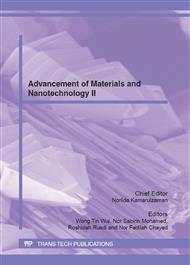p.279
p.285
p.290
p.294
p.303
p.308
p.312
p.317
p.321
Studies of ENR-50 and LiN(SO2CF3)2 Electrolyte System
Abstract:
In this work, electrolyte films based on epoxidized natural rubber-50 (ENR-50) and lithium imide (LiN(SO2CF3)2) salt were prepared using solution casting method. X-ray diffraction pattern for undoped ENR-50 shows a broad peak which indicated amorphous nature of the film. The intensity of ENR-50 peak decreases with increase in salt concentration. Thermal property study was carried out using Differential Scanning Calorimetry (DSC) to determine glass transition temperature, Tg. The DSC result displays an increasing trend of Tg with increase in salt concentration and opposite to the trend of variation of conductivity with salt concentration. This indicates that the increase in Tg dose not give adverse effect on ionic conductivity. The increase in Tg with concentration of salt may be due to formation of transient cross-linking between ENR-50 chains via the coordinated interaction between ENR-50 chains and LiN(SO2CF3)2. The highest room temperature ionic conductivity obtained is in the order of 10-5 S cm-1 for the film containing 50 wt.% of LiN(SO2CF3)2. The ionic conductivity of this electrolyte system increases with increase in temperature and obeys the Vogel-Tammam-Fulcher (VTF) relation in the temperature range of 303–373 K. The increase in ionic conductivity of the electrolyte system could be correlated to increase in number of charge carriers and the migration rate of charge carriers.
Info:
Periodical:
Pages:
303-307
Citation:
Online since:
July 2012
Authors:
Keywords:
Price:
Сopyright:
© 2012 Trans Tech Publications Ltd. All Rights Reserved
Share:
Citation:


